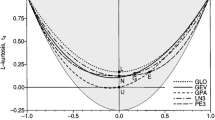Abstract
In extreme value analysis one is interested in parametric models for the distribution of maxima and exceedances. Suitable models are obtained by using limiting distributions. In the following lines, we cite some basic results from extreme value theory. The reader is referred to (Embrechts, Kliippelberg and Mikosch, 1997) and (Resnick, 1987) for a theoretical and to (Reiss and Thomas, 1997) for an applied introduction. A more detailed review is given in (McNeil, 1997).
Access this chapter
Tax calculation will be finalised at checkout
Purchases are for personal use only
Preview
Unable to display preview. Download preview PDF.
Similar content being viewed by others
Bibliography
Balkema, A. and de Haan, L. (1974), ‘Residual life time at great age.’, Ann. Probab. 2, 792–804.
Dekkers, A., Einmahl, J. and de Haan, L. (1989), ‘A moment estimator for the index of an extreme-value distribution’, Ann. Stat. 17, 1833–1855.
Drees, H. (1995), ‘Refined pickands estimators of the extreme value index’, Ann. Stat. 23, 2059–2080.
Embrechts, P., Kliippelberg, C. and Mikosch, T. (1997), Modelling Extremal Events, Springer.
Falk, M., Hüsler, J. and Reiss, R.-D. (1994), Laws of Small Numbers: Extremes and Rare Events, DMV-Seminar, Birkhäuser, Basel.
Fisher, R. and Tippett, L. (1928), ‘Limiting forms of the frequency distribution of the largest and smallest member of a sample’, Proc. Camb. Phil. Soc. 24, 180–190.
Gamma, E., Helm, R., Johnson, R. and Vlissides, J. (1995), Design Patterns, Addison-Wesley, Reading, Massachusetts.
OMG (1995), The common object request broker: Architecture and specification, Technical report, Object Management Group.
Huber, P. (1994), Languages for statistics and data analysis, in P. Dirschedl and R. Ostermann, eds, ‘Computational Statistics’, Physica, Heidelberg.
Leadbetter, M. and Nandagopalan, S. (1989), On exceedance point processes for stationary sequences under mild oscillation restrictions, in J. Hüsler and R.-D. Reiss, eds, ‘Extreme Value Theory’, number 51 in ‘Lect. Notes in Statistics’, Springer, New York.
McNeil, A. (1997), ‘Estimating the tails of loss severity distributions using extreme value theory’, ASTIN Bulletin 27, 117–137.
Pickands, J. (1975), ‘Statistical inference using extreme order statistics’, Ann. Stat. 3, 119–131.
Reiss, R.-D. and Thomas, M. (1997), Statistical Analysis of Extreme Values, Birkhäuser, Basel.
Reiss, R.-D. and Thomas, M. (1999), Extreme value analysis, in ‘XploRe-The Statistical Environment’, Springer, New York.
Resnick, S. (1987), Extreme Values, Regular Variation, and Point Processes, Springer, New York.
Editor information
Editors and Affiliations
Rights and permissions
Copyright information
© 2000 Springer Science+Business Media New York
About this chapter
Cite this chapter
Kleinow, T., Thomas, M. (2000). Computational Resources for Extremes. In: Franke, J., Stahl, G., Härdle, W. (eds) Measuring Risk in Complex Stochastic Systems. Lecture Notes in Statistics, vol 147. Springer, New York, NY. https://doi.org/10.1007/978-1-4612-1214-0_13
Download citation
DOI: https://doi.org/10.1007/978-1-4612-1214-0_13
Publisher Name: Springer, New York, NY
Print ISBN: 978-0-387-98996-9
Online ISBN: 978-1-4612-1214-0
eBook Packages: Springer Book Archive




